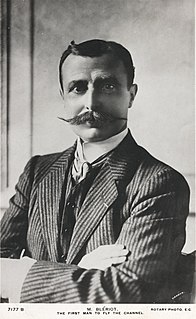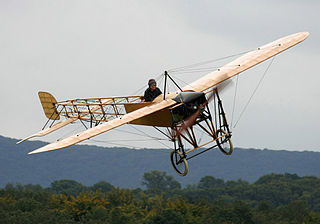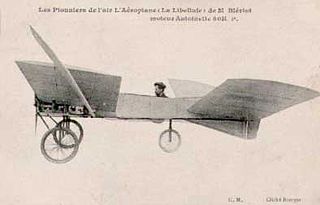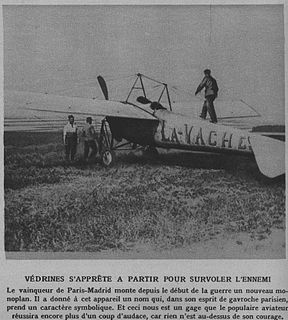Related Research Articles

Louis Charles Joseph Blériot was a French aviator, inventor, and engineer. He developed the first practical headlamp for cars and established a profitable business manufacturing them, using much of the money he made to finance his attempts to build a successful aircraft. Blériot was the first to use the combination of hand-operated joystick and foot-operated rudder control as used to the present day to operate the aircraft control surfaces. Blériot was also the first to make a working, powered, piloted monoplane. In 1909 he became world-famous for making the first airplane flight across the English Channel, winning the prize of £1,000 offered by the Daily Mail newspaper. He was the founder of Blériot Aéronautique, a successful aircraft manufacturing company.

Gabriel Voisin was a French aviation pioneer and the creator of Europe's first manned, engine-powered, heavier-than-air aircraft capable of a sustained (1 km), circular, controlled flight, which was made by Henry Farman on 13 January 1908 near Paris, France. During World War I the company founded by Voisin became a major producer of military aircraft, notably the Voisin III. Subsequently, he switched to the design and production of luxury automobiles under the name Avions Voisin.

The Blériot XI is a French aircraft of the pioneer era of aviation. The first example was used by Louis Blériot to make the first flight across the English Channel in a heavier-than-air aircraft, on 25 July 1909. This is one of the most famous accomplishments of the pioneer era of aviation, and not only won Blériot a lasting place in history but also assured the future of his aircraft manufacturing business. The event caused a major reappraisal of the importance of aviation; the English newspaper The Daily Express led its story of the flight with the headline "Britain is no longer an Island".

The Blériot-SPAD S.34 was a French twin-seat, single-engine biplane flight training aircraft designed in 1920. The side-by-side seating arrangement was unique for its time. 150 aircraft were built, 125 for the French Air Force, who used them until 1936.

Blériot Aéronautique was a French aircraft manufacturer founded by Louis Blériot. It also made a few motorcycles between 1921 and 1922 and cyclecars during the 1920s.

The Blériot VI "Libellule" ("Dragonfly"), was built in 1907 and was one of the series of experimental aircraft built by Louis Blériot which eventually led to the Blériot XI aircraft in which he made the first flight across the English Channel.

The Blériot VIII was a French pioneer era aeroplane built by Louis Blériot, significant for its adoption of both a configuration and a control system that were to set a standard for decades to come.
Aerial reconnaissance using heavier-than-air machines was an entirely new science that had to be improvised step-by-step. Early operations were low-level flights with the pilot often dismounting from the plane to report verbally to the nearest officers. Photographic support was urgently developed, initially requiring a full-time photographer on board to handle the heavy, awkward equipment. The interpreting of aerial images was an important new speciality, essential for accurate mapping. By 1915, air-to-ground radio was in use for reconnaissance pilots.
The Blériot 73 was a large First World War French heavy night bomber designed and built by Blériot to the BN3 specification. Only a single prototype was built, which crashed on landing from its first flight, killing the pilot. The Blériot 74, Blériot 75 and Blériot 76, respectively, a heavy bomber / airliner, airliner and heavy bomber, directly evolved mfrom the Blériot 71 / Blériot 73 bombers.
The Bréguet 610 was a reconnaissance seaplane built in 1934 by the Bréguet company.
The Blériot XLII was a First World War French reconnaissance plane designed and built by Blériot.
The Blériot XLIII was a First World War French reconnaissance plane designed and built by Blériot.
The Bleriot XXV was a single-seat, high-wing, pusher-type canard monoplane designed by Louis Bleriot. Only one aircraft was built.

The Bleriot XXVII was a middle-wing, single-seat racing aircraft designed by Louis Bleriot.

The Blériot XXXVI Torpille was an observation monoplane designed in France by Louis Bleriot during the early 1910s. The Blériot XXXVIbisLa Vache was operated by Jules Védrines on several daring missions behind enemy lines in the early months of the war.
The Bleriot XXXIX was a single-seat observation monoplane designed in France by Louis Bleriot during the early 1910s.
The Bleriot XL was a two-seat observation sesquiplane designed in France by Louis Bleriot during the early 1910s. Its structure was made of metallic materials.
References
- ↑ "Blériot XL - Blériot 40 - Observation - Un siècle d'aviation française". Aviafrance.com. 2017-06-07. Retrieved 2019-02-04.